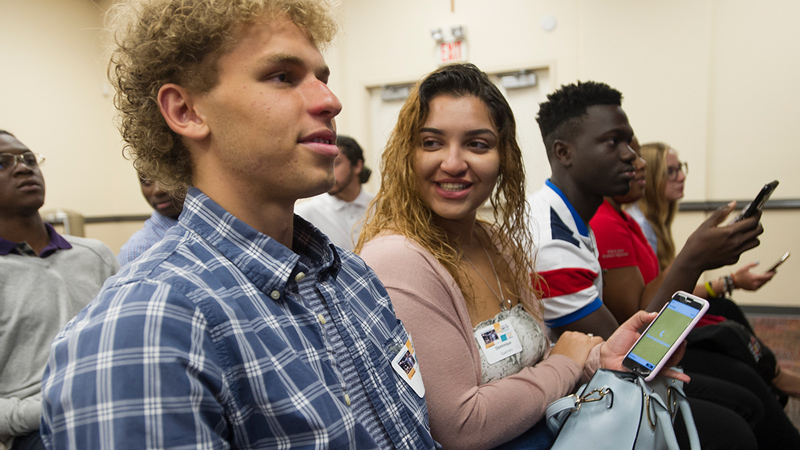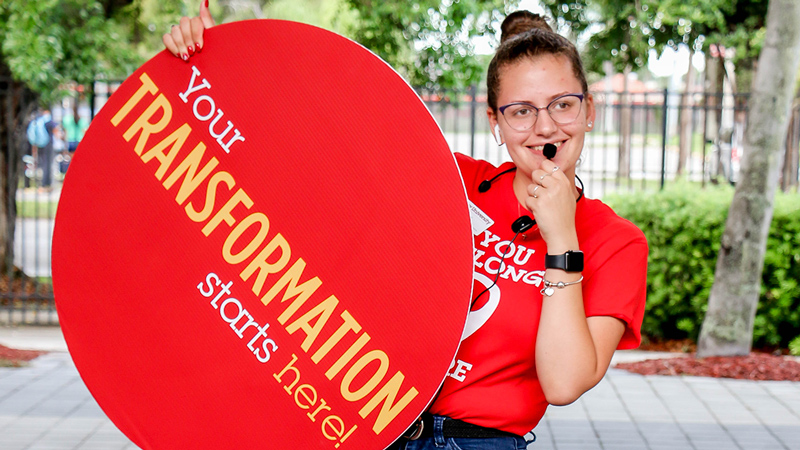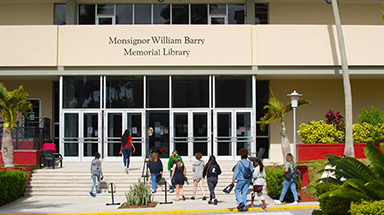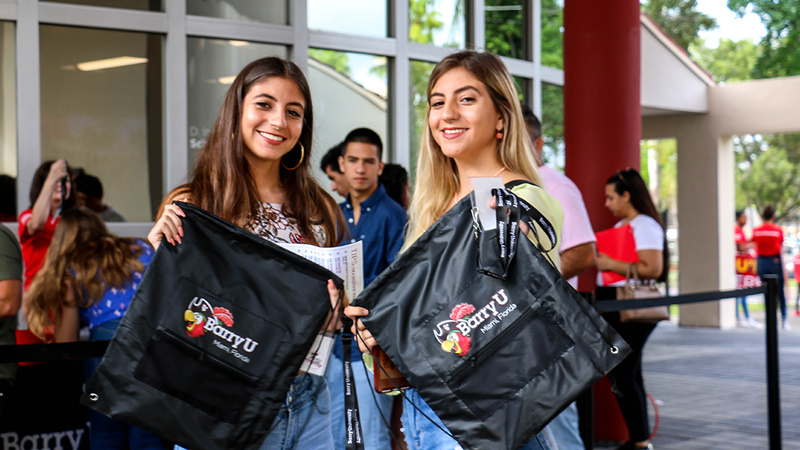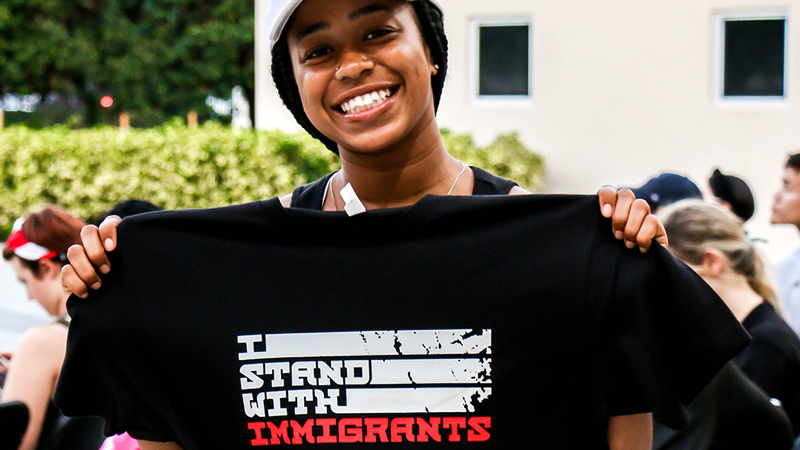|
GENDER |
NUMBER OF STUDENTS |
% OF TOTAL* |
|
Female |
1,292 |
63% |
|
Male |
748 |
37% |
Student Body Diversity
Fall 2023 Enrollment of Full-Time Undergraduate Students By Gender
*Total based on fall 2023 enrollment of 2,040 full-time undergraduate students.
Source: Office of Institutional Research
Fall 2023 Enrollment of Full-Time Undergraduate Students By Gender

Source: Office of Institutional Research
Fall 2023 Enrollment of Full-Time Undergraduate Students by Ethnicity
|
ETHNICITY |
NUMBER OF STUDENTS |
% OF TOTAL* |
|
Nonresident Alien |
232 |
11% |
|
Hispanic |
699 |
34% |
|
American Indian or Alaskan Native |
6 |
0% |
|
Asian |
29 |
1% |
|
Black or African American |
780 |
38% |
|
Hawaiian or Pacific Islander |
2 |
0% |
|
White non-Hispanic |
209 |
10% |
|
Two or more races |
64 |
3% |
|
Unknown |
19 |
1% |
|
Total |
2040 |
100% |
*Total based on fall 2023 enrollment of 2,040 full-time undergraduate students.
Source: Office of Institutional Research
Fall 2023 Enrollment of Full-Time Undergraduate Students by Ethnicity

Source: Office of Institutional Research
For additional information on Student Body Diversity visit College Navigator webpage https://nces.ed.gov/collegenavigator/?q=barry&s=all&id=132471 and/or IR webpage
Enrollment By Financial Aid Status
Fall 2023 Enrollment of Full-Time Traditional Undergraduate Students by Financial Aid Status
| FINANCIAL AID STATUS | Number of Students | % of Total* |
|---|---|---|
| Pell Grant recipients | 1087 | 56% |
| Direct Subsidized Loan recipients who did not receive a Pell grant | 226 | 12% |
| Students who did not receive either a Pell grant or a Direct subsidized Loan | 636 | 33% |

*Total based on fall 2023 enrollment of 2,040 full-time undergraduate students.
Source: Office of Institutional Research
Student Outcomes
Retention and Transfer-Out Rates
| FALL 2022 STUDENT GROUP* | NO. OF STUDENTS | TRANSFER-OUT RATE | RETENTION RATE | |
|---|---|---|---|---|
| ALL STUDENTS | 589 | 23% | 58% | |
| GENDER | Male | 213 | 20% | 59% |
| Female | 376 | 25% | 57% | |
| RACE/ETHNICITY | Non-resident alien | 41 | 0 | 78% |
| Hispanic | 190 | 27% | 57% | |
| American Indian or Alaskan Native | 2 | 0% | 100% | |
| Asian | 11 | 27% | 55% | |
| Black or African American | 240 | 22% | 55% | |
| Native Hawaiian or Pacific Islander | 1 | 0% | 100% | |
| White | 72 | 31% | 54% | |
| Two or more races | 31 | 26% | 58% | |
| Unknown | 1 | 0% | 100% | |
| FINANCIAL AID STATUS | Pell grant recipients | 349 | 24% | 56% |
| Recipient of subsidized Stafford loan without Pell grant | 84 | 25% | 55% | |
| Received neither Pell grant nor Subsidized Stafford Loan | 156 | 20% | 64% | |
*The latest cohort for which there is complete first-to-second year retention and transfer-out rates information is the fall 2022 cohort. Partially available information for the fall 2023 cohort is available at http://www.barry.edu/institutional-research/quick-facts.html
Graduation and Transfer-Out Rates
Graduation and Transfer-Out Rates of First-Time, Full-Time, Degree-Seeking, First-Year Students Disaggregated by Gender, Ethnicity, and Financial Aid Status
| FALL 2017 STUDENT GROUP* | NO. OF STUDENTS | NOT GRADUATED/STILL ENROLLED AS OF FALL 2023 | TRANSFER-OUT RATE AT 150% OF NORMAL TIME | GRADUATION RATE AT 100% OF NORMAL TIME | GRADUATION RATE AT 150% OF NORMAL TIME | |
|---|---|---|---|---|---|---|
| ALL STUDENTS | 604 | 1% | 41% | 18% | 37% | |
| GENDER | Male | 183 | 1% | 39% | 13% | 31% |
| Female | 421 | 1% | 41% | 20% | 39% | |
| RACE/ETHNICITY | Non-resident alien | 37 | 0% | 11% | 27% | 51% |
| Hispanic | 215 | 1% | 36% | 25% | 43% | |
| American Indian or Alaskan Native | 5 | 0% | 60% | 0% | 0% | |
| Asian | 11 | 0% | 64% | 18% | 27% | |
| Black or African American | 257 | 1% | 42% | 12% | 32% | |
| Native Hawaiian or Pacific Islander | 2 | 0% | 50% | 0% | 50% | |
| White | 70 | 1% | 59% | 14% | 30% | |
| Two or more races | 4 | 0% | 75% | 0% | 25% | |
| Unknown | 3 | 0% | 67% | 0% | 0% | |
| FINANCIAL AID STATUS | Pell grant recipients | 403 | 1% | 41% | 15% | 34% |
| Recipients of subsidized Stafford loan without Pell grant | 58 | 2% | 45% | 19% | 34% | |
| Received neither Pell grant nor Subsidized Stafford Loan | 143 | 0% | 38% | 25% | 44% | |
*The latest cohort for which there is complete six-year graduation and transfer-out rates information is the fall 2017 cohort. Partially available information for the fall 2018 cohort is available at http://www.barry.edu/institutional-research/quick-facts.html
Source: Office of Institutional Research
First-To-Second Year Retention Rate of First-Time, Full-Time, Degree-Seeking, First-Year Students, 2022 Cohort

Source: Office of Institutional Research
Intercollegiate Athletics
Completion/Graduation Rates for Students Receiving Athletically Related Student AID
Information on Enrollment and Completion/Graduation Rates for Students Receiving Athletically Related Student Aid is available at:
http://gobarrybucs.com/sports/2016/5/25/academic-success.aspx?path=academics
Gender Equity in Athletics
Information on Intercollegiate Athletic Program Participation Rates and Financial Support Data is available at:
Graduate and Professional Education Placement for Graduates
Types Of Graduate and Professional Education in Which Barry’s Graduates Enroll Within One Year of Graduation
Approximately 7% of students who completed a bachelor's degree from Barry University between July 1, 2020 and June 30, 2021 went on to enroll in a graduate or professional program at the same institution. The most common programs students enrolled in are as follows:
- Master of Business in Business Administration
- Master of Public Administration
- Master of Science Human Performance and Wellness
- Master of Science in Counseling
Top Graduates Programs by Enrollment for Barry 2020-2021 Returning Graduates

Source: Office of Institutional Research
Job Placement for Graduates
Employment and Earnings
The employment rate within Florida for Barry University graduates with an undergraduate degree is higher than the average rate for graduates from other independent colleges and universities in Florida and comparable to the average employment rate from Florida public universities. The average salary for Barry University graduates with undergraduate degrees is higher than the average salary for graduates from independent and public universities. Complete details of Barry University FETPIP related documents can be found at the following website: www.barry.edu/institutional-research/fetpip.html
2020-2021 Bachelor's Degree Graduates
|
University |
Graduates |
% Employed in Florida |
Mean Earnings |
Median Earnings |
|
Barry University |
662 |
66% |
$65,832 |
$58,128 |
|
Average for 30 ICUF Schools |
606 |
53% |
$45,697 |
$40,748 |
*Independent Colleges and Universities of Florida. Complete details of Barry University FETPIP related documents can be found at the following website: https://www.barry.edu/institutional-research/fetpip.html
The Florida Education and Training Placement Information Program (FETPIP) is a data collection and consumer reporting system established by Florida statute. The purpose of FETPIP is to track students who have graduated, exited, or completed an educational or training program within the State of Florida. Among other services, the FETPIP tracking system reports on within-state employment of students following graduation from a college or university in the state. Complete details of this program can be found at the following website: http://www.fldoe.org/accountability/fl-edu-training-placement-info-program/
Additional Information
For additional information on Student Outcomes visit College Navigator webpage



